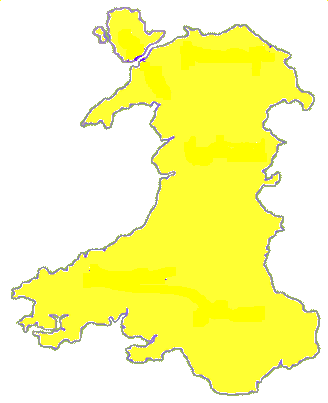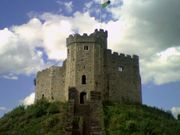THEOSOPHY
WALES


Cardiff Castle
Return to Homepage
Roman forts
There were
three successive Roman forts on the site of Cardiff Castle,
most notably a late 3rd century structure, some walls of which can still be
seen today. One of the gates was reconstructed in Victorian times.
Medieval
castle
Cardiff Castle was built for Robert Fitzhamon
in 1091, on the site of and incorporating some walls of the previous Roman
fort, although it was mostly of timber in the usual motte
and bailey style. His son-in-law, Robert of Gloucester, rebuilt in stone, including the twelve-sided
keep which can still be seen today. Robert, Duke of Normandy
who was imprisoned there by his younger brother, King Henry I from 1106 until
1134. In 1158 it was the scene for a daring kidnapping carried out by
one Ifor Bach (Ivor the Little). In the Welsh Revolt of 1183, the castle was
attacked and much damaged, but an expected siege nearly a hundred years later,
during the reign of Llywelyn the Last, never emerged.
Gilbert de Clare had refortified many of the defences in readiness.
The Despenser family held the castle throughout the 14th
century. In 1317, Llywelyn Bren
was imprisoned there for revolting against the English and executed in a most
humiliating manner. Four years later, the castle was taken by a combined force
of marcher lords attempting to overthrow King Edward II. okDuring Owain Glynd?r's rebellion in the early 1400's his supporters took
the castle in 1404 and set the town alight (a Cardiff pub is named in memory of Glyndwr). Later it
came into the possession of the Beauchamp Earls of Warwick, who built the living quarters along the western
wall including the Octagon Tower. King Henry VII gave it to his
uncle, Jasper Tudor in 1488. By 1550, the castle was held by the Herberts who added further embellishments. They held the
castle for the King during the Civil War, but it was eventually taken by
Parliamentary forces. In 1776, it passed to the Earl of Bute. The family made various alterations, including
landscaping by Capability Brown.
Victorian
mansion
In the early
19th century the castle was enlarged and refashioned in an early Gothic Revival
style for John Crichton-Stuart, 2nd Marquess of Bute by Henry Holland. But its transformation began
in 1868 when the 3rd Marquess commissioned William Burges to undertake a massive rebuilding which turned the
castle into a 19th century fantasy of a medieval palace, with a series of rooms
that, perhaps, constitute the highest achievement of later Victorian Gothic
Revival design. The coming together of the Marquess,
enormously rich, early Catholic convert and steeped in a romantic vision of the
mediaeval world and Burges, pre-eminent
art-architect, committed Goth and hugely-talented designer forged one of the
great patron/architect relationships and led to a succession of dazzling
architectural triumphs of which Cardiff Castle is the greatest of all.
Rebuilding
began with the Clock Tower, planned 1866-1868 and begun in 1869. The towers
continue westward, the Tank Tower, the Guest Tower, the Herbert Tower and the
Beauchamp Tower, part Burges, part Holland, part 15th
and 16th century, creating a skyline, best observed from Bute
Park, that echoes Burges' unbuilt
design for the Law Courts and presents a visually-stunning image of a mediaeval
city.
Within the
Castle, the succession of sumptuous apartments; the Winter
and Summer Smoking Rooms, the Chaucer Room, the Arab Room, Lord Bute's Bedroom, the Roof Garden, repeatedly illustrates Burges' supreme skill as an art-architect. Taking complete
control of the designing, the building, the decoration and the furnishing of
the apartments, and using his favoured team of
Nicholls, Crace, Lonsdale, Burges
created a suite of rooms in a unique Gothic Revival style that is unrivalled.
Access and
events
The castle
was later sold to the city of Cardiff by the Bute family in 1947 for £1. It is now a popular
tourist attraction, and houses a regimental museum in addition to the ruins of
the old castle and the Victorian reconstruction. It sits in the expansive
grounds of Bute Park.
The castle
has hosted a number of rock concerts and performances and has the capacity to
accommodate over 10,000 people. Notable concerts include the Stereophonics Live at Cardiff Castle
in June 1998 and Green Day in 2000. In 1948 a crowd of 16,000, a record for
British Baseball game, watched Wales defeat England in Cardiff Castle
grounds. Cardiff Castle plays host to Cardiff University's Summer Ball each year. It is also the site of Wales' largest Mardi Gras
held every August.
Return to Homepage

THEOSOPHY
WALES
For more info on Theosophy
Try these
Dave’s Streetwise Theosophy Boards
The Theosophy Website that
Welcomes Absolute Beginners
Theosophy in Cardiff
Theosophy in Wales
Wales! Wales! Theosophy Wales
The
All Wales Guide to
Getting Started in Theosophy
This
is for everybody not just people in Wales
Cardiff Lodge’s Instant Guide to Theosophy
Cardiff Theosophy Start-Up
A Free Intro to Theosophy
Cardiff Theosophical Archive
Cardiff Blavatsky Archive
Blavatsky Blogger
Independent
Theosophical Blog
Quick Blasts of Theosophy
One Liners & Quick Explanations
Great Theosophists
The Most Basic Theosophy Website
in the Universe
If you run a
Theosophy Group you can use
this as an
introductory handout
Theosophy
The
New Rock ‘n Roll
The Key to Theosophy
The Voice of the Silence
The South of Heaven Guide to
Theosophy and Devachan
The South of Heaven Guide
To Theosophy and Dreams
The South of Heaven Guide
To Theosophy and Angels
Theosophy and Help From
The Universe
Feelgood Theosophy
Visit the Feelgood Lodge
The Tooting Broadway
Underground Theosophy Website
The Spiritual Home of Urban Theosophy
The Mornington Crescent
Underground Theosophy Website
The Earth Base for Evolutionary Theosophy
Try these if you are
looking for a
local
Theosophy
Group or Centre
UK Listing of Theosophical
Groups
Worldwide Directory of
Theosophical Links
International Directory of
Theosophical Societies


